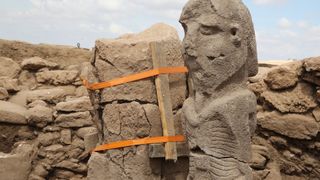Statues of auto-eroticisist, wild boar and vulture unearthed at temple sites.
A 7.5-foot-tall statue of a man clutching his penis was unearthed at one of the oldest temple sites in Turkey.
This human-like sculpture was found at Karahan Tepe. The person represented may actually be depicted as being dead. The newly found sculptures date back about 11,000 years. (Image credit: Anadolu Agency / Contributor via Getty Images)
Archaeologists in Turkey have unearthed a nearly 11,000-year-old statue that may depict a giant man clutching his penis, along with a life-size wild boar statue. The two statues come from the neighboring sites of Gobekli Tepe and Karahan Tepe, which are among the oldest temple sites in the world.
The wild boar statue, which is carved from limestone, was found at Gobekli Tepe and dates to between 8700 B.C. and 8200 B.C. It measures 4.4 feet (1.4 meters) long and 2.3 feet (0.7 m) high, the German Archaeological Institute said in a
statement. Archaeologists detected red, black and white pigments on its surface, indicating that the sculpture was once painted. Archaeologists unearthed the large sculpture of the manat the site of Karahan Tepe, about 22 miles (35 kilometers) from Gobekli Tepe. It depicts a 7.5-foot-tall (2.3 m) man, according to a translated
statement from Turkey's ministry of culture and tourism. The person's ribs, spines and shoulders are particularly pronounced, and the person may actually be depicted as being dead, the statement said.
These discoveries, "represent the latest spectacular finds from these sites which are transforming our understanding of pre-agricultural communities,"
Benjamin Arbuckle, an anthropology professor at the University of North Carolina at Chapel Hill who was not involved with the excavations, told Live Science in an email.
Researchers also found a small sculpture of a vulture nearby at Karahan Tepe. While archaeologists didn't say how old the newfound statues at, Karahan Tepe are, the site is around 11,000 years old and
contains other sculptures and buildings.
https://www.livescience.com/archaeo...giant-man-clutching-penis-unearthed-in-turkey




